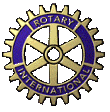 Rotary
Clubs of Ojai Living Treasures
Rotary
Clubs of Ojai Living Treasures
Living
Treasures...
utilizing our community's greatest resource, Its people.
|
About Rotary |
|
|
* ROTARY is an organization of business and professional leaders united worldwide, who provide humanitarian service, encourage high ethical standards in all vocations, and help build goodwill and peace in the world. * ROTARY is the world's first service club. The first Rotary club was founded in Chicago, Illinois, USA on 23 February 1905. * ROTARY is some 1.2 million service-minded men and women belonging to more than 28,000 Rotary clubs in virtually every nation in the world. * ROTARIANS meet weekly for fellowship and interesting and informative programs dealing with topics of local and global importance. Membership reflects a wide cross section of community representation. * ROTARIANS plan and carry our a remarkable variety of humanitarian, educational, and cultural exchange programs that touch people's lives in their local communities and our world community. * ROTARY is The Rotary Foundation, which each year provides some US$90 million for international scholarships, cultural exchanges, and humanitarian projects large and small that improve the quality of life for millions of people. Rotary is widely regarded as the world's largest private provider of international educational scholarships. * ROTARY is PolioPlus, Rotary's commitment to work with national and international health organizations on the goal of polio eradication by the year 2005, Rotary's 100th anniversary. More than one billion children in developing nations have been immunized against polio through PolioPlus Grants. 419-EN-(697) OBJECT OF ROTARY The Object of Rotary can be considered the foundation stone on which the Rotary house is built. This brief statement, 106 words in its current form, is a key element of the Rotary International Constitution. It states the essential purpose of the organization -- "to encourage and foster the ideal of service as a basis of worthy enterprise" -- and then lists four areas by which this "ideal of service" can be fostered. They are: through the development of acquaintance as an opportunity for service; the promotion of high ethical standards in business and professions; through service in one's personal, business and community life; and theadvancement of international understanding, goodwill and peace. This articulation of Rotary ideals began with the first constitution of 1906 which had |
three objects: promotion of business interests, promotion of good fellowship and the advancement of the best interests of the community. By 1910 there were five objects in the statement and by 1915, six. The document went through several further revisions until a final revision in 1951 which made it a single "Object" which is manifested in four separate ways. The "ideal of service" is the key phrase, expressing an attitude of being a thoughtful and helpful person in all of one's endeavors. The Object of Rotary is to encourage and foster the ideal of service as a basis of worthy enterprise and, in particular, to encourage and foster: 1.The development of acquaintance as an opportunity for service; 2.High ethical standards in business and professions; the recognition of the worthiness of all useful occupations, and the dignifying of each Rotarian's occupation as an opportunity to serve society; 3.The application of the ideal of service in each Rotarian's personal, business, and community life; 4.The advancement of international understanding, goodwill, and peace through a world fellowship of business and professional persons united in the ideal of service. THE 4-WAY TEST One of the most widely printed and quoted statements of business ethics in the world is the Rotary 4-Way Test. It was created by Rotarian Herbert J. Taylor in 1932 when he was asked to take charge of a company that was facing bankruptcy. Taylor looked for a way to save the struggling company mired in depression-caused financial difficulties. He drew up a 24-word code of ethics for all employees to follow in their business and professional lives. The 4-Way Test became the guide for sales, production, advertising and all relations with dealers and customers, and the survival of the company is credited to this simple philosophy. Herb Taylor became president of Rotary International in 1954-55. The 4-Way Test was adopted by Rotary in 1943 and has been translated into more than a hundred languages and published in thousands of ways. Of the things we think, say or do: 1.Is it the Truth? 2.Is it Fair to all concerned? 3.Will it build goodwill and better friendships? 4.Will it be beneficial to all concerned?
|
Graphics by Art for the web
